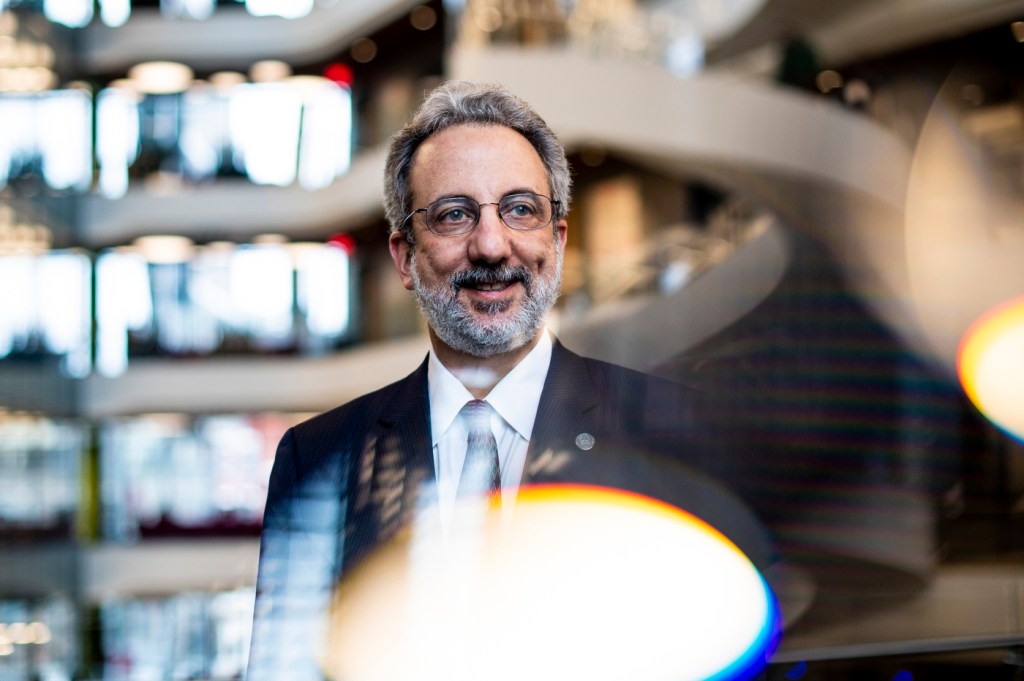Northeastern University professor Jerome F. Hajjar elected to National Academy of Engineering

When an earthquake greatly damaged a brand new steel building in California, Jerome F. Hajjar wanted to understand why. A structural engineer who was just beginning an academic career, he was interested in how buildings, bridges, and other structures withstand extreme stress without collapsing.
His research in the wake of the 1994 earthquake in Northridge, California, which caused “unexpected fractures in steel buildings,” has since helped to establish safer, more resilient structures.
Hajjar, now the department chair and CDM Smith Professor of Civil and Environmental Engineering at Northeastern, was recently elected a member of the National Academy of Engineering. He got the news, he says, during a routine faculty meeting with colleagues in the College of Engineering.
“I was stunned, absolutely stunned,” Hajjar says of the news, which came via email.
That was Feb. 9. Since then, Hajjar’s received hundreds of messages from friends, family members, and colleagues from around the world, congratulating him on the honor. National Academy of Engineering members are elected in a highly selective, multiyear process about which little is known. The organization—which belongs to a cohort of related nonprofits that together makeup the National Academies of Sciences, Engineering, and Medicine—selects among a pool of the world’s top engineers to choose its newest members, who go on to help author reports on some of the major industry challenges, while educating the next generation of engineers.
“The work of high-achieving faculty members like Jerry exemplifies Northeastern’s strong and steady rise in academic excellence,” wrote David Madigan, provost and senior vice president for academic affairs, to the university community.
Gregory D. Abowd, dean of Northeastern’s College of Engineering, called Hajjar’s election to the national academy “a momentous achievement.”
“With the election to the [National Academy of Engineering] comes the opportunity and responsibility to serve the nation through participation in the National Academies workshops and reports on engineering issues of importance related to national security, energy, education of future engineers, resilience of urban infrastructure, and sustainability,” Abowd wrote in announcing the news.
Abowd continued: “Under his leadership, the power to innovate has enabled unprecedented accomplishments in the Civil and Environmental Engineering Department that are reflective of the future of the fast-evolving field.”
Members elected to the national academy are recognized for their “outstanding contributions to engineering research, practice, or education, including, where appropriate, significant contributions to the engineering literature,” as well as for pioneering “new and developing fields of technology, making major advancements in traditional fields of engineering, or developing/implementing innovative approaches to engineering education,” the academy said in announcing this year’s appointments.
Hajjar, who is being recognized for his contributions to the development of “design criteria and models for stability and seismic design of innovative steel and composite structures,” joins a class of newly elected members that includes the likes of Satya Nadella, chairman and chief executive officer of Microsoft; Noubar Afeyan, co-founder and chairman of Moderna; and Elon Musk, founder and chief executive officer of SpaceX.
Since the early 1990s, Hajjar’s research has focused on structural stability, or how buildings, bridges, and other structures can cope with extreme loads without collapsing. After receiving his PhD in structural engineering from Cornell University, he began working as an engineer for the global architectural firm Skidmore, Owings & Merrill, where he studied the designs of some of the world’s most iconic buildings.
It was there that he became interested in the challenges of simulating the behavior of these structures under extreme loads—as well as how they would respond to events like earthquakes.
“I do a mix of large-scale experimental testing and developing computational formulations and theories for design,” Hajjar says. “Over time, some of these approaches to stability, and the innovations to structural systems for seismic designs, have influenced the national design codes, or have inspired engineers to adopt these systems or ideas into their own work.”
Hajjar says some of his early work in the field was spurred by events, such as the historic California earthquake, which prompted re-examination of the prevailing design methods.
“Most owners at the time felt their structures shouldn’t have had an issue,” Hajjar says. “We did a lot of research around the country in the following years to try to understand why—and I helped contribute to some of that.”
William F. Baker, a structural engineer best known for engineering the Burj Khalifa, the world’s tallest building, worked alongside Hajjar at Skidmore, Owings & Merrill. The pair served on American Institute of Steel Construction committees together, working on structural stability in the early 1990s.
Baker, who’s served on the National Academy of Engineering since 2011, says Hajjar has been deeply influential in shaping modern building codes, as well improving steel-concrete composite structures.
“Nowadays, there’s a lot of composite design, and he had a hand in a lot of that,” Baker says.
Hajjar’s work also helped introduce a new structural concept for resilience: That all the energy from an extreme event, such as an earthquake, can be mitigated through “replaceable energy-dissipating components.” These materials, called “energy dissipators,” help dampen or absorb the energy generated by earthquakes so as to prevent serious structural damage to beams, columns, and braces.
And as the threat of climate change on the world’s great cities continues to grow, Hajjar has also helped advance the concept of “design for deconstruction,” which focuses on how structures can be taken apart at the end of their useful life. The idea, he says, is to harness the useful components of a disused structure for reuse in an effort to reduce waste and the amount of energy needed for recycling.
“Resilience and sustainability are really important to me,” Hajjar says.
For media inquiries, please contact media@northeastern.edu.





